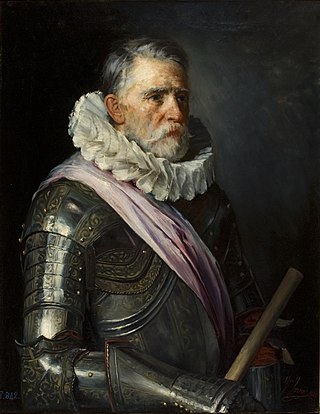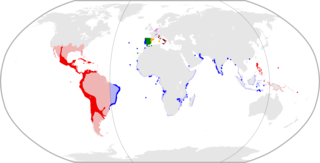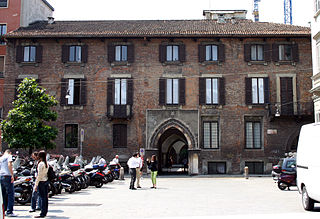Life
Giulio was the third son of Count Fabio Visconti and Margharita Arese. The family was a side branch of the noble family of Visconti of Milan, which can be traced back to Charlemagne. This line died out with him in the male line, since his marriage to Teresa Cusani, produced only one daughter.
After the end of the War of the Spanish Succession, he entered the service of the Habsburgs, the new masters of his homeland in the Duchy of Milan. In 1726 he was appointed Minister plenipotentiary of the Austrian Netherlands and thus the highest administrative officer under the governorship of Archduchess Maria Elisabeth. During this time he was also entrusted with diplomatic missions to London.
His promotion to the independent position of Viceroy of Naples in 1733 can be interpreted as an indication of the satisfaction of the court in Vienna. His actual term of office there only lasted until 1734, when the Austrian troops and the administration had to vacate the country before the advancing Spanish troops led by Charles of Bourbon.
In a decree of Emperor Charles VI from June 18, 1738, he is described as Grandee of Spain, Knight of the Order of the Golden Fleece, Privy Councilor of State, General of the Artillery and Obersthofmeister of the Empress.

The War of the Polish Succession was a major European conflict sparked by a civil war in the Polish–Lithuanian Commonwealth over the succession to Augustus II the Strong, which the other European powers widened in pursuit of their own national interests. France and Spain, the two Bourbon powers, tested the power of the Austrian Habsburgs in Western Europe, as did the Kingdom of Prussia, whilst Saxony and Russia mobilized to support the eventual victor. The fighting in Poland–Lithuania resulted in the accession of Augustus III, who in addition to Russia and Saxony, was politically supported by the Habsburgs.

Charles III was King of Spain in the years 1759 to 1788. He was also Duke of Parma and Piacenza, as Charles I (1731–1735); King of Naples, as Charles VII; and King of Sicily, as Charles III (1735–1759). He was the fourth son of Philip V of Spain and the eldest son of Philip's second wife, Elisabeth Farnese. He was a proponent of enlightened absolutism and regalism.

Luis de Requesens y Zúñiga was a Spanish general, sailor, diplomat and politician. He served as governor of the Duchy of Milan (1572–1573) and as governor of the Spanish Netherlands (1573–1576).

The Duchy of Milan was a state in Northern Italy, created in 1395 by Gian Galeazzo Visconti, then the lord of Milan, and a member of the important Visconti family, which had been ruling the city since 1277.

The nobility of Italy comprised individuals and their families of the Italian Peninsula, and the islands linked with it, recognized by the sovereigns of the Italian city-states since the Middle Ages, and by the kings of Italy after the unification of the region into a single state, the Kingdom of Italy.

Pedro Henriquez d'Azevedo y Alvarez de Toledo, Count of Fuentes de Valdepero was a Spanish general and statesman.

The Battle of Bitonto was a Spanish victory over Austrian forces near Bitonto in the Kingdom of Naples in the War of Polish Succession. The battle ended organized Austrian resistance outside a small number of fortresses in the kingdom.

The aristocratic House of Borromeo were merchants in San Miniato around 1300 and became bankers in Milan after 1370. Vitaliano de' Vitaliani, who acquired the name of Borromeo from his uncle Giovanni, became the count of Arona in 1445. His descendants played important roles in the politics of the Duchy of Milan and as cardinals in the Catholic Reformation. In 1916, the head of the family was granted the title Prince of Angera by the King of Italy.

Count Wirich Philipp von Daun was an Austrian Field Marshal of the Imperial Army in the War of Spanish Succession, and father of the better known Leopold Josef Graf Daun. In 1710 he was created Prince of Teano.

The Palazzo Litta, also known as the Palazzo Arese-Litta, is a Baroque structure in Milan, northern Italy, opposite San Maurizio al Monastero Maggiore, and dating from the period of Spanish rule of the city. In 2018, it served as a cultural center, housing exhibition spaces, offices, and a theater.
The siege of Capua was the last major military action of the War of the Polish Succession in the Kingdom of Naples. Austrian forces of the Habsburg monarchy, under the command of the Austrian Marshal Otto Ferdinand von Abensberg und Traun, withstood for seven months a blockade begun in April 1734 by Spanish and French forces under Count Marsillac. General Traun surrendered the fortress of Capua in November 1734 with full honors of war, primarily because of exhausted provisions and ammunition, but also because it was clear no relief was coming to the isolated garrison.

The Kingdom of Sicily was ruled by the House of Savoy from 1713 until 1720, although they lost control of it in 1718 and did not relinquish their title to it until 1723. The only king of Sicily from the House of Savoy was Victor Amadeus II. Throughout this period Sicily remained a distinct realm in personal union with the other Savoyard states, but ultimately it secured for the House of Savoy a royal title and a future of expansion in Italy rather than in France. During this period, the Savoyard monarch used his new title to affirm his sovereign independence.

The Council of Italy, officially, the Royal and Supreme Council of Italy was a ruling body and key part of the government of the Spanish Empire in Europe, second only to the monarch himself. It was based in Madrid and administered the Spanish territories in Italy: the Kingdom of Naples, the Kingdom of Sicily, the State of the Presidi and the Duchy of Milan.

Palazzo Borromeo is a 14th-century building located at piazza Borromeo 12 in Milan, region of Lombardy, Italy. It was built as the home and business headquarters of the Borromeo family, merchant-bankers from Tuscany. Some of the building complex was badly damaged during World War II in Allied bombings of 1943 but was reconstructed and restored to its 15th-century appearance. It contains an important fresco cycle from the 1440s and is one of the finest examples of a Milanese patrician palace from the early Renaissance.

From 1700 to 1720, the Kingdom of Sardinia, as a part of the Spanish empire, was disputed between two dynasties, the Habsburgs and the Bourbons. With the death of Charles II, the last of the Spanish Habsburgs, on 1 November 1700, the throne passed to Duke Philip of Anjou, although the Emperor Leopold I also had a claim. Leopold was especially desirous of obtaining the Spanish inheritance in the Southern Netherlands and in Italy, which included Sardinia. With the failure of France to abide by the Second Partition Treaty, the other European powers lined up on the side of the Habsburgs. The Treaty of the Hague allotted to the Emperor the Spanish possessions in Italy. Imperial troops invaded Italy to seize them, and the War of the Spanish Succession began.

The Arese are a prominent family of the Milanese nobility.

Palazzo Arese Borromeo is an historic noble palace situated in Cesano Maderno, in the Province of Monza and Brianze, Lombardy, Italy.
















